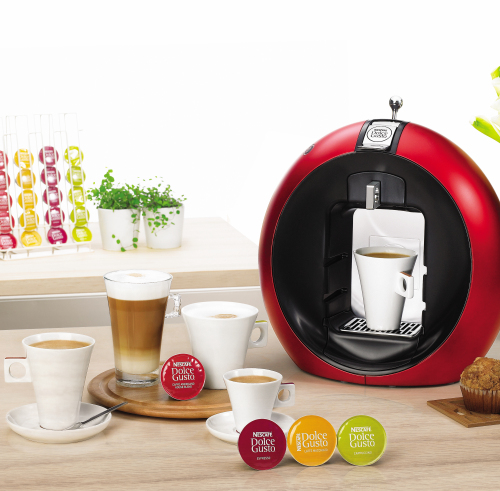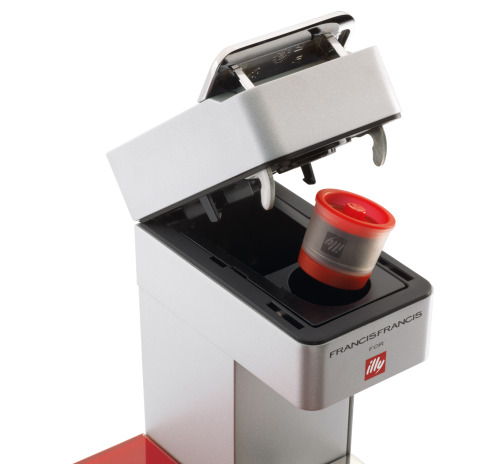Do coffee capsules pose a threat to baristas?
At first glance Apgujeong’s Cafe Italico looks like a run-of-the-mill coffee shop.
The flagship store of this 20-outlet cafe franchise, however, is anything but average.
Visitors will quickly notice the lack of baristas in the back whipping out cappuccinos. They will most likely blink when they see that the menu asks them to pay 500 won extra if they want to select their own capsule of choice.
Come again?
That’s right. Every single coffee-based drink at Cafe Italico is made from coffee capsules a.k.a. pods.
Pods or capsules are ground, pre-tamped coffee stored into airtight vessels that can be popped into a special machine for a single serving of espresso.
Convenient, clean and consistent are the key charms of the capsule. Just one push of the button, or a light tug on a lever, and, voila, a steaming cup of joe whose full flavor has been preserved by its spacesuit-style container emerges.
Since Nestle’s Nespresso first entered the Korean coffee market in 2007 with its hip premium aluminum pods, capsule coffee has quickly gone on to become the new brew du jour.
Just walk into any department store. Customers can be found at Nespresso’s colorful boutiques, carefully selecting their capsules of choice or at Nescafe Dolce Gusto’s booth, trying out frothy pod-made latte macchiatos before deciding whether or not to buy a machine.

Nestle’s Nescafe Dolce Gusto Circolo machine is the brand’s second bestseller in the Korean market. Dolce Gusto whips out everything from frothy cappuccinos to latte macchiatos. (Nestle Korea Ltd.)
Right now, there are at least eight different capsule coffee brands on the market, including Coffee Bean and Tea Leaf, which launched their pods this January.
It is a pod invasion, and it has created a new breed of coffee drinkers. They are called pod people.
Where do pod people hang? Apparently, they not only enjoy their capsules at home and at the office. They also convene at coffee shops.
Cafe Italico launched its first capsule-only shop in October 2009, said Choi Hee-don, strategy planning director of Da Vinci Marketing Group, which oversees the coffee store franchise.
“There are no baristas in our cafes,” said Choi, who said that many of their franchisees are coffee store novices.
Cafe Italico, however, stands at the extreme end of the pod coffee shop spectrum. Places like Hongdae’s Free Tempo, which serves both Nespresso and handcrafted brews, are a more moderate example of pod-serving cafes.
Moderate or extreme, the infiltration of capsule coffee into the cafe market has given rise to several crucial questions.
Does pod coffee taste better than coffee made by professional baristas? Will the proliferation of capsule coffee in cafes pose a threat to baristas?
Nestle Korea Ltd.’s Grant Phillips, who is the executive director for the coffee and creamers business unit, was quick to assert that both Nescafe Dolce Gusto and Nespresso, which are part of Nestle, put out “extremely good coffee.”
Nespresso Korea country manager Ross Gatta wrote via e-mail that the brand began with the idea of enabling “anyone to create a perfect cup of espresso coffee, with exquisite crema (the foam that forms on top), tantalizing aroma and full-bodied taste just like a skilled barista.”
Lee Sun-hwa, sales and marketing manager for the Korean branch of the famous Italian coffee company Illycaffe, went so far as to say that Illy’s iperEspresso capsules make espresso that is on par with espresso extracted by a professional barista.

Just pop an iperEspresso capsule into Illy’s sleek and modern Francis Francis Y1 machine for a single serving of espresso (Illycaffe Korea Co., Ltd.)
To demonstrate, Lee popped an iperEspresso Lungo capsule into their Francis Francis X7 machine and pressed the button. What emerged was a smooth, strong and caramel-tinged brew with a thick beige-edged crema.
Master barista Bang Jong-koo, who runs his own cafe called Coffee Lab in Hongdae, is less quick to put the capsule on a pedestal.
In his opinion, capsule-produced espressos and Americanos are “okay.”
Bang, who trained in Italy at Torrefazione Musetti and is a 2005 Korea Barista Champion, stressed that how the coffee is ground and how it is roasted also matters.
He added that when milk enters the equation, it affects how the coffee tastes even more.
“Capsule coffee cannot be customized the way a barista can customize coffee.”
Bang seems to be all about customization. At Coffee Lab, all 10 to 15 blends of coffee are roasted in-house to create the establishment’s 26 coffee-based drinks.
According to Bang, how a barista roasts, blends, grinds and brews his creations form the identity of the cafe.
“It’s about character,” said Bang, emphasizing the need to personalize the coffee shop experience.
Illycaffe Korea Co., Ltd.’s Lee agrees that the barista is privy to skills that can change the way coffee-based drinks, especially those beyond the realm of the standard espresso, taste.
“They have their own know-how,” said Lee.
Even Free Tempo book cafe manager Kim Bum-jun, whose shop started selling Nespresso when it opened in March 2010, was reserved about his impressions of the premium capsule brew, stating that he thinks it is attractive to coffee initiates but that once one becomes a coffee expert, hand drip coffee can be more alluring.
Kim stated that they brought in Nespresso more for decorative purposes rather than to “raise sales.”
“Not many people come in looking for Nespresso,” he said. “Over 90 percent of our coffee sales come from our regular coffee menu.”
Based on that, it looks like capsule coffee does not pose a serious threat to professional baristas, and both Illy’s Lee and Nestle’s Phillips, even Da Vinci of Cafe Italico’s Choi, agree.
“I think there is a limit to the number of people who will only seek out capsule-made coffee in cafes,” said Choi.
Lee and Phillips stated that Illy’s and Nescafe Dolce Gusto’s main capsule coffee consumers purchase pods for home-use.
“I don’t see the market going away from baristas,” said Phillips. “I think the barista will always exist. People visit (cafes) for the show. A barista is a part of that.”
By Jean Oh (
oh_jean@heraldcorp.com)







